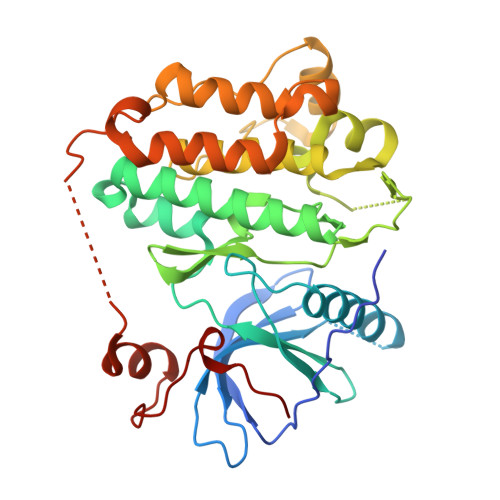Insight into Targeting Exon20 Insertion Mutations of the Epidermal Growth Factor Receptor with Wild Type-Sparing Inhibitors.
Lategahn, J., Tumbrink, H.L., Schultz-Fademrecht, C., Heimsoeth, A., Werr, L., Niggenaber, J., Keul, M., Parmaksiz, F., Baumann, M., Menninger, S., Zent, E., Landel, I., Weisner, J., Jeyakumar, K., Heyden, L., Russ, N., Muller, F., Lorenz, C., Bragelmann, J., Spille, I., Grabe, T., Muller, M.P., Heuckmann, J.M., Klebl, B.M., Nussbaumer, P., Sos, M.L., Rauh, D.(2022) J Med Chem 65: 6643-6655
- PubMed: 35486541
- DOI: https://doi.org/10.1021/acs.jmedchem.1c02080
- Primary Citation of Related Structures:
7A6I, 7A6J, 7A6K, 7B85 - PubMed Abstract:
Despite the clinical efficacy of epidermal growth factor receptor (EGFR) inhibitors, a subset of patients with non-small cell lung cancer displays insertion mutations in exon20 in EGFR and Her2 with limited treatment options. Here, we present the development and characterization of the novel covalent inhibitors LDC8201 and LDC0496 based on a 1 H -pyrrolo[2,3- b ]pyridine scaffold. They exhibited intense inhibitory potency toward EGFR and Her2 exon20 insertion mutations as well as selectivity over wild type EGFR and within the kinome. Complex crystal structures with the inhibitors and biochemical and cellular on-target activity document their favorable binding characteristics. Ultimately, we observed tumor shrinkage in mice engrafted with patient-derived EGFR-H773_V774insNPH mutant cells during treatment with LDC8201. Together, these results highlight the potential of covalent pyrrolopyridines as inhibitors to target exon20 insertion mutations.
Organizational Affiliation:
PearlRiver Bio GmbH, Otto-Hahn-Str. 15, 44227 Dortmund, Germany.
















